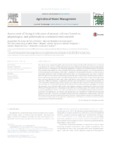Por favor, use este identificador para citar o enlazar este ítem:
http://www.alice.cnptia.embrapa.br/alice/handle/doc/1064841| Título: | Assessment of drought tolerance of peanut cultivars based on physiological and yield traits in a semiarid environment. |
| Autor: | PEREIRA, J. W. de L.  ALBUQUERQUE, M. B.   MELO FILHO, P. A.   NOGUEIRA, R. J. M. C.   LIMA, L. M. de   SANTOS, R. C. dos   |
| Afiliación: | JACQUELINE WANESSA DE LIMA PEREIRA, UFRPE; MANOEL BANDEIRA ALBQUERQUE, Universidade Federal da Paraíba; PÉRICLES ALBUQUERQUE MELO FILHO, UFRPE; REJANE JUREMA MANSUR CUSTÓDIO NOGUEIRA, UFRPE; LIZIANE MARIA DE LIMA, CNPA; ROSEANE CAVALCANTI DOS SANTOS, CNPA. |
| Año: | 2016 |
| Referencia: | Agricultural Water Management, n. 166, p. 70-76, 2016. |
| Descripción: | tThe regular water supply during life cycle is essential to determine the yield in the legumes. In semiaridenvironments, the irregular rainfall and high temperature influence the phenology of crops impairing theyield. Peanut is an oleaginous crop with broad adaptation to tropical and semiarid climates, but yield isoften harmed when plants face water irregularities during reproductive phase. The recommendation ofcultivars tolerant to environments with water?limitation is indispensable to farmers in order to ensurereasonable production when drought settles down. Here, we evaluating peanut bred lines in order toassess drought tolerance based on physiological and yield traits, in greenhouse and field assays. In green-house experiment, 2 genotypes (BR 1, drought tolerant and the sensible LViPE-06) and 2 descendant bredlines (earliness-LBM Branco and a mid-runner, LBR Branco) were submitted to 21 days of total watersupression. Diffusive resistance, transpiration and leaf water potential were measured by porometer (LI1600), from fully expanded leaves at mid canopy. Root length was also measured at final period of waterstress. Further, in a 2-year field experiment carried out in semiarid environment (Barbalha, CE, Brazil),the genotypes were evaluated under rainfed and irrigation, aiming to estimating the yield trait and theefficiency of drought tolerance. Physiological and yield traits of all genotypes were altered under waterstress and significant responses were observed. Both top lines showed physiological ability to toleranceto drought, but LBM Branco, an earliness and upright line, was classified as drought tolerant showingbehavior near to BR 1. The losses in pod and seed yield were low, comparing to runner parent (LViPE-06).LBR Branco showed an intermediary performance between parents and was classified as moderately tol-erant. Based on physiological and agronomic performances, LBM Branco can later be recommended formanagement in semiarid environment. |
| Thesagro: | Genótipo Amendoim |
| NAL Thesaurus: | Water stress Legumes Phenology Semiarid zones |
| Tipo de Material: | Artigo de periódico |
| Acceso: | openAccess |
| Aparece en las colecciones: | Artigo em periódico indexado (CNPA)  |
Ficheros en este ítem:
| Fichero | Descripción | Tamaño | Formato | |
|---|---|---|---|---|
| Assesmentofdroughttoleranteofpeanut.pdf | 840.16 kB | Adobe PDF |  Visualizar/Abrir |









